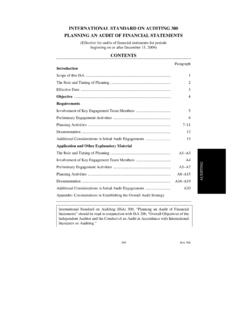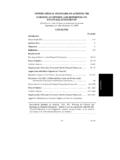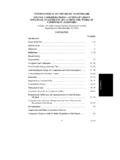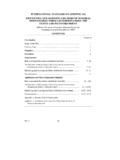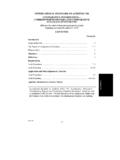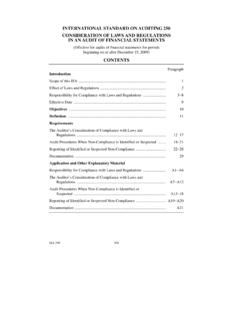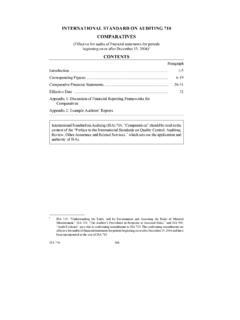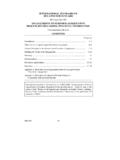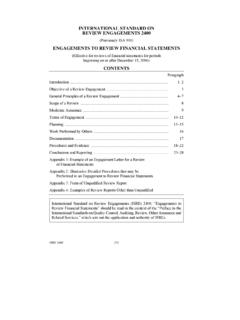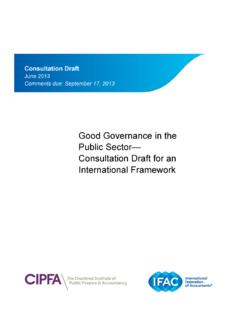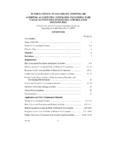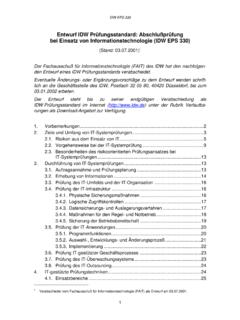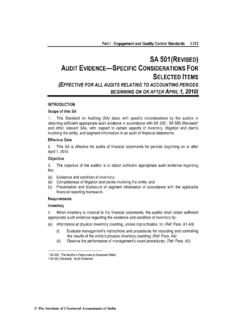Transcription of INTERNATIONAL STANDARD ON AUDITING 330 …
1 INTERNATIONAL STANDARD ON AUDITING 330. THE AUDITOR'S RESPONSES TO ASSESSED RISKS. (Effective for audits of financial statements for periods beginning on or after December 15, 2009). CONTENTS. Paragraph Introduction Scope of this ISA .. 1. Effective Date .. 2. Objective .. 3. Definitions .. 4. Requirements Overall Responses .. 5. Audit Procedures Responsive to the Assessed Risks of Material Misstatement at the Assertion Level .. 6 23. Adequacy of Presentation and Disclosure .. 24. Evaluating the Sufficiency and Appropriateness of Audit Evidence .. 25 27. Documentation .. 28 30. Application and Other Explanatory Material Overall Responses .. A1 A3. Audit Procedures Responsive to the Assessed Risks of Material Misstatement at the Assertion Level .. A4 A58. Adequacy of Presentation and Disclosure .. A59. Evaluating the Sufficiency and Appropriateness of Audit Evidence.
2 A60 A62. Documentation .. A63. INTERNATIONAL STANDARD on AUDITING (ISA) 330, The Auditor's Responses to Assessed Risks should be read in conjunction with ISA 200, Overall Objectives of the Independent Auditor and the Conduct of an Audit in Accordance with INTERNATIONAL standards on AUDITING .. ISA 330 322. THE AUDITOR'S RESPONSES TO ASSESSED RISKS. Introduction Scope of this ISA. 1. This INTERNATIONAL STANDARD on AUDITING (ISA) deals with the auditor's responsibility to design and implement responses to the risks of material misstatement identified and assessed by the auditor in accordance with ISA. 3151 in an audit of financial statements. Effective Date 2. This ISA is effective for audits of financial statements for periods beginning on or after December 15, 2009. Objective 3. The objective of the auditor is to obtain sufficient appropriate audit evidence regarding the assessed risks of material misstatement, through designing and implementing appropriate responses to those risks.
3 Definitions 4. For purposes of the ISAs, the following terms have the meanings attributed below: (a) Substantive procedure An audit procedure designed to detect material misstatements at the assertion level. Substantive procedures comprise: (i) Tests of details (of classes of transactions, account balances, and disclosures); and (ii) Substantive analytical procedures. (b) Test of controls An audit procedure designed to evaluate the operating effectiveness of controls in preventing, or detecting and correcting, AUDITING . material misstatements at the assertion level. Requirements Overall Responses 5. The auditor shall design and implement overall responses to address the assessed risks of material misstatement at the financial statement level. (Ref: Para. A1 A3). Audit Procedures Responsive to the Assessed Risks of Material Misstatement at the Assertion Level 6. The auditor shall design and perform further audit procedures whose nature, timing and extent are based on and are responsive to the assessed risks of material misstatement at the assertion level.
4 (Ref: Para. A4 A8). 1. ISA 315, Identifying and Assessing the Risks of Material Misstatement through Understanding the Entity and Its Environment.. 323 ISA 330. THE AUDITOR'S RESPONSES TO ASSESSED RISKS. 7. In designing the further audit procedures to be performed, the auditor shall: (a) Consider the reasons for the assessment given to the risk of material misstatement at the assertion level for each class of transactions, account balance, and disclosure, including: (i) The likelihood of material misstatement due to the particular characteristics of the relevant class of transactions, account balance, or disclosure (that is, the inherent risk); and (ii) Whether the risk assessment takes account of relevant controls (that is, the control risk), thereby requiring the auditor to obtain audit evidence to determine whether the controls are operating effectively (that is, the auditor intends to rely on the operating effectiveness of controls in determining the nature, timing and extent of substantive procedures); and (Ref: Para.)
5 A9 A18). (b) Obtain more persuasive audit evidence the higher the auditor's assessment of risk. (Ref: Para. A19). Tests of Controls 8. The auditor shall design and perform tests of controls to obtain sufficient appropriate audit evidence as to the operating effectiveness of relevant controls if: (a) The auditor's assessment of risks of material misstatement at the assertion level includes an expectation that the controls are operating effectively (that is, the auditor intends to rely on the operating effectiveness of controls in determining the nature, timing and extent of substantive procedures); or (b) Substantive procedures alone cannot provide sufficient appropriate audit evidence at the assertion level. (Ref: Para. A20 A24). 9. In designing and performing tests of controls, the auditor shall obtain more persuasive audit evidence the greater the reliance the auditor places on the effectiveness of a control.
6 (Ref: Para. A25). Nature and Extent of Tests of Controls 10. In designing and performing tests of controls, the auditor shall: (a) Perform other audit procedures in combination with inquiry to obtain audit evidence about the operating effectiveness of the controls, including: (i) How the controls were applied at relevant times during the period under audit;. (ii) The consistency with which they were applied; and (iii) By whom or by what means they were applied. (Ref: Para. A26 . A29). ISA 330 324. THE AUDITOR'S RESPONSES TO ASSESSED RISKS. (b) Determine whether the controls to be tested depend upon other controls (indirect controls), and, if so, whether it is necessary to obtain audit evidence supporting the effective operation of those indirect controls. (Ref: Para. A30 A31). Timing of Tests of Controls 11. The auditor shall test controls for the particular time, or throughout the period, for which the auditor intends to rely on those controls, subject to paragraphs 12.
7 And 15 below, in order to provide an appropriate basis for the auditor's intended reliance. (Ref: Para. A32). Using audit evidence obtained during an interim period 12. If the auditor obtains audit evidence about the operating effectiveness of controls during an interim period, the auditor shall: (a) Obtain audit evidence about significant changes to those controls subsequent to the interim period; and (b) Determine the additional audit evidence to be obtained for the remaining period. (Ref: Para. A33 A34). Using audit evidence obtained in previous audits 13. In determining whether it is appropriate to use audit evidence about the operating effectiveness of controls obtained in previous audits, and, if so, the length of the time period that may elapse before retesting a control, the auditor shall consider the following: (a) The effectiveness of other elements of internal control, including the control environment, the entity's monitoring of controls, and the entity's risk assessment process.
8 AUDITING . (b) The risks arising from the characteristics of the control, including whether it is manual or automated;. (c) The effectiveness of general IT controls;. (d) The effectiveness of the control and its application by the entity, including the nature and extent of deviations in the application of the control noted in previous audits, and whether there have been personnel changes that significantly affect the application of the control;. (e) Whether the lack of a change in a particular control poses a risk due to changing circumstances; and (f) The risks of material misstatement and the extent of reliance on the control. (Ref: Para. A35). 325 ISA 330. THE AUDITOR'S RESPONSES TO ASSESSED RISKS. 14. If the auditor plans to use audit evidence from a previous audit about the operating effectiveness of specific controls, the auditor shall establish the continuing relevance of that evidence by obtaining audit evidence about whether significant changes in those controls have occurred subsequent to the previous audit.
9 The auditor shall obtain this evidence by performing inquiry combined with observation or inspection, to confirm the understanding of those specific controls, and: (a) If there have been changes that affect the continuing relevance of the audit evidence from the previous audit, the auditor shall test the controls in the current audit. (Ref: Para. A36). (b) If there have not been such changes, the auditor shall test the controls at least once in every third audit, and shall test some controls each audit to avoid the possibility of testing all the controls on which the auditor intends to rely in a single audit period with no testing of controls in the subsequent two audit periods. (Ref: Para. A37 A39). Controls over significant risks 15. If the auditor plans to rely on controls over a risk the auditor has determined to be a significant risk, the auditor shall test those controls in the current period.
10 Evaluating the Operating Effectiveness of Controls 16. When evaluating the operating effectiveness of relevant controls, the auditor shall evaluate whether misstatements that have been detected by substantive procedures indicate that controls are not operating effectively. The absence of misstatements detected by substantive procedures, however, does not provide audit evidence that controls related to the assertion being tested are effective. (Ref: Para. A40). 17. If deviations from controls upon which the auditor intends to rely are detected, the auditor shall make specific inquiries to understand these matters and their potential consequences, and shall determine whether: (Ref: Para. A41). (a) The tests of controls that have been performed provide an appropriate basis for reliance on the controls;. (b) Additional tests of controls are necessary; or (c) The potential risks of misstatement need to be addressed using substantive procedures.
